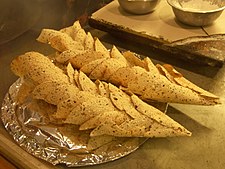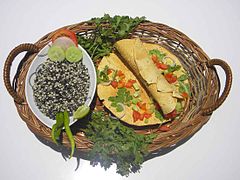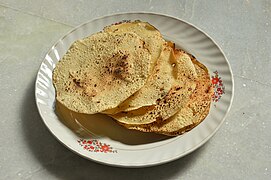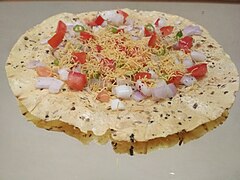Papadam: Difference between revisions
→Regional variations: wikilink added unreferenced tag added |
→Ingredients and preparation: source added |
||
| Line 39: | Line 39: | ||
==Ingredients and preparation== |
==Ingredients and preparation== |
||
''Papadum'' can be prepared from different ingredients and methods. Arguably, the most popular recipe uses flour ground from hulled split black gram mixed with black pepper, salt, and a small amount of vegetable oil and a food-grade alkali, and the mixture is kneaded. A well-kneaded dough is then flattened into very thin rounds and then dried and stored for later preparation and consumption. It may also contain rice, [[Jackfruit]], [[sago|Sabudana]], etc., as main ingredients. Cracked black pepper, red chili powder, [[Asafoetida]], or cumin or [[sesame]] seeds are often used as flavoring agents. |
''Papadum'' can be prepared from different ingredients and methods. Arguably, the most popular recipe uses flour ground from hulled split black gram<ref name="SmarttNwokolo2012">{{cite book|author1=J. Smartt|author2=Emmanuel Nwokolo|title=Food and Feed from Legumes and Oilseeds|url=https://books.google.com/books?id=cvfSBwAAQBAJ&pg=PA12|date=6 December 2012|publisher=Springer Science & Business Media|isbn=978-1-4613-0433-3|page=28}}</ref> mixed with black pepper, salt, and a small amount of vegetable oil and a food-grade alkali, and the mixture is kneaded. A well-kneaded dough is then flattened into very thin rounds and then dried and stored for later preparation and consumption. It may also contain rice, [[Jackfruit]], [[sago|Sabudana]], etc., as main ingredients. Cracked black pepper, red chili powder, [[Asafoetida]], or cumin or [[sesame]] seeds are often used as flavoring agents. |
||
===Business=== |
===Business=== |
||
Revision as of 20:56, 28 March 2019
 Home style Indian papad | |
| Alternative names | Papad, appadam, papar, pampad, happala, poppadam, poppadom, appalam, pappadam, puppodum |
|---|---|
| Place of origin | Indian Subcontinent |
| Region or state | Indian subcontinent with region variations |
| Main ingredients | Lentils, black gram, chickpeas, rice flour |
| Variations | Rice, tapioca (sabudana), or potato papad, masala pappad, garlic pappad, ginger pappad |
A Papadum is a thin, crisp, disc-shaped food from the Indian subcontinent, typically based on a seasoned dough usually made from peeled black gram flour (urad flour), either fried or cooked with dry heat (usually flipping it over an open flame). Flours made from other sources such as lentils, chickpeas, rice, tapioca, or potato can be used.
Papadum is typically served as an accompaniment to a meal in India, Bangladesh, Nepal, and Sri Lanka or as an appetizer or snack, sometimes with toppings such as chopped onions, chopped carrots, chutneys or other dips, and condiments. In Pakistan, these are made of rice and often used as a snack or meal accompaniment. In certain parts of India, poppadoms which have been dried, but not cooked, are used in curries and vegetable dishes. Papadums has been a part of the Indian subcontinent for generations [citation needed] and is an intrisic part of everyday meals.
Papadums are called appalam in Tamil Nadu, pappadum in Kerala, appadam in Andhra/Telangana, happala in Karnataka, and papad in Gujarat.[citation needed] They are mainly made in Rajasthan, Maharastra, and Gujarat in the north. In the south, Kerala, Madurai district in Tamil Nadu, Kanchipuram, and Chennai are major manufacturers.
Etymology
Papadum is derived from the Sanskrit word parpaṭa (पर्पट).
Regional variations


Papadum recipes vary from region to region and from family to family. They are typically made from flour or paste derived from either lentils, chickpeas, black gram, rice, or potato.
Salt and peanut oil are added to make a dough, which can be flavored with seasonings such as chili, cumin, garlic, or black pepper. Sometimes, baking soda or slaked lime is also added. The dough is shaped into a thin, round flatbread and then dried (traditionally in the sun), and can be cooked by deep frying, roasting over an open flame, toasting, or microwaving, depending on the desired texture.
Bikaner is the hub of chickpea and green gram papadam manufacturing. Potato papadam is made in Varanasi. Most sweet- and snack-selling national companies are also involved in this business.
In most Indian restaurants around the world, they are served as an appetizer with dips, which often include mango chutney, lime pickle, onion chutney, and raita.
Ingredients and preparation
Papadum can be prepared from different ingredients and methods. Arguably, the most popular recipe uses flour ground from hulled split black gram[1] mixed with black pepper, salt, and a small amount of vegetable oil and a food-grade alkali, and the mixture is kneaded. A well-kneaded dough is then flattened into very thin rounds and then dried and stored for later preparation and consumption. It may also contain rice, Jackfruit, Sabudana, etc., as main ingredients. Cracked black pepper, red chili powder, Asafoetida, or cumin or sesame seeds are often used as flavoring agents.
Business
Papadum is often associated with the empowerment of women in India.[2] Many individual and organized businesses run by women produce papad, pickles, and other snacks. This provides them regular income from minimal financial investments. Shri Mahila Griha Udyog Lijjat Papad is an organization (owned and run solely by women) which produces large quantities of papadums on the open market, which started as a small business in the late 1950s,[3][4] with an annual income in 2005 of about ₹650 crore (US$78 million). However, with the recent growth of modern trade in India and the growing consumer awareness, other brands have been gaining in popularity within this category.
Gallery
-
A stack of roasted papadums, ready to be served
-
Rice papadum
-
Uradal papadum
-
Paparis served in Lisbon, Portugal
-
Toasted papadum served with dal and rice
-
Fire-toasting papadum
-
Fire-toasted papadum
-
Masala Papad
See also
References
- ^ J. Smartt; Emmanuel Nwokolo (6 December 2012). Food and Feed from Legumes and Oilseeds. Springer Science & Business Media. p. 28. ISBN 978-1-4613-0433-3.
- ^ World Bank. "Empowering Women in Urban India: Shri Mahila Griha Udyog Lijjat Papad" (PDF). Empowerment Case Studies. World Bank. Retrieved 2012-09-23.
- ^ Malathi Ramanathan. "Grassroots Developments in Women's Empowerment in India: Case Study of Shri Mahila Griha Udyog Lijjat Papad (1959–2000)" (PDF). Archived from the original (PDF) on 2007-03-15. Retrieved 2007-01-15.
{{cite web}}: Unknown parameter|dead-url=ignored (|url-status=suggested) (help) - ^ "organization - The Beginning". Lijjat. Archived from the original on 2007-09-27. Retrieved 2006-02-04.
{{cite web}}: Unknown parameter|dead-url=ignored (|url-status=suggested) (help)
External links
 Media related to Papadums at Wikimedia Commons
Media related to Papadums at Wikimedia Commons













